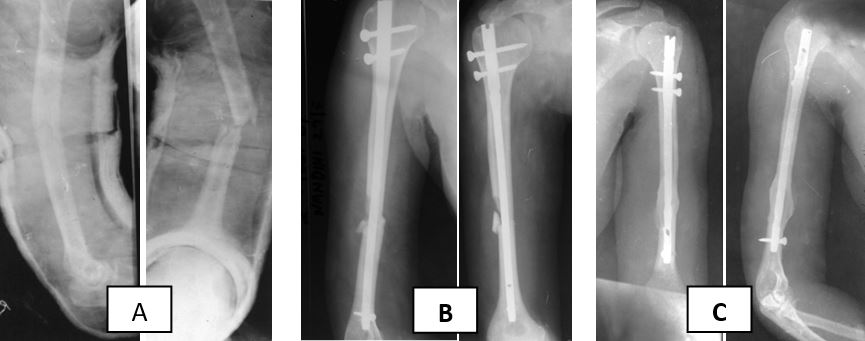Comparison of Outcome of Comminuted Fractures of Shaft Humerus Treated with Interlock Nailing and Anterior Bridge Plating
Abstract
Background: Humeral shaft fractures are uncommon injuries constituting about 3-6 % of all fractures and are most commonly caused by high energy trauma and usually occurs in middle third of the shaft. Operative treatment for fracture of shaft humerus has always been controversial and subject of debate among the orthopaedic surgeon particularly after bridge plating was introduced few years back. [1,2]
Objectives: In this study, we have compared the two system of surgical treatment i.e. Interlocking nail and bridge plating by minimal invasive percutaneous plate osteosynthesis. MIPPO both in terms of intra-operative and post-operative outcome.
Methods: This was randomized control trial study. All patients with comminuted fractures of shaft of humerus that met the criteria for operative interventions presenting to the Department of Orthopaedics, SAIMS in the study period and giving informed consent were included in the study. Sample size was taken 15 patients in each group.
Results:The usual mode of injury in both the groups was fall or assault and road traffic accident. The operating time, Hospital stay, dosage of antibiotic, Early mobilization, Amount of blood loss, Time taken in the procedure for both the groups were comparable with no significant difference. ASES shoulder scoring was similar in both the groups at final follow up.
Downloads
References
Canale, S. T., Beaty, J. H., & Campbell, W. C. (2013). Campbell's operative orthopaedics. Philadelphia, PA: Elsevier/Mosby.
Sarmiento A, Kinman PB, Galvin EG, Schmitt RH, Phillips JG. Functional bracing of fractures of the shaft of the humerus. J Bone Joint Surg Am. 1977;59:596–601.
Chapman J R, Henley M B, Agel J, et al. Randomized prospective study of humeral shaft fracture fixation: Intramedullary nails versus plates. J Orthop Trauma; 14(3): 162–6.
Farouk O, Krettek C, Miclau T, Schandelmaier P, Guy P, Tscherne H. Minimally invasive plate osteosynthesis: does percutaneous plating disrupt femoral blood supply less than the traditional technique? J Orthop Trauma. 1999;13:401–406. doi: 10.1097/00005131-199908000-00002.
Apivatthakakul T, Arpornchayanon O. Minimally invasive plate osteosynthesis (MIPO) combined with distraction osteogenesis in the treatment of bone defects. A new technique of bone transport: a report of two cases. Injury. 2005;36(4):530–538. doi: 10.1016/j.injury.2004.05.036
Yu, Bin-fendgMD; Liu, Liang-Le-MD,Yang, Guo-Jing MD;Zhang, Lei MD, Lin,Xi-peng MD. Comparison of minimally invasive plate osteosynthesis and conventional plate osteosynthesis for humeral shaft fracture: A meta- analysis. Medicine: September 2016 – volume 95 – issue 39 – p e4955.
Singisetti K, Ambedkar M. Nailing versus plating in humerus shaft fractures: A prospective comparative study. IntOrthop 2010;34:571-6.
Lian K, Wang L, Lin D, Chen Z. Minimally Invasive Plating Osteosynthesis for Mid-distal Third Humeral Shaft Fractures. Orthopedics. 2013; 36: e1025-e1032. doi: 10.3928/01477447-20130724-18
M. Changulani, U. K. Jain, and TulsiKeswaniIntOrthop. Comparison of the use of the humerus intramedullary nail and dynamic compression plate for the management of diaphyseal fractures of the humerus. A randomised controlled study. IntOrthop. Jun 2007; 31(3): 391–395.
Dabezies EJ, Banta CJ, Murphy CP, d’Ambrosia RD. Plate fixation of the humeral shaft for acute fractures with and without radial nerve injuries. J Orthop Trauma 1992;6:10-3.
Bell MJ, Beauchamp CG, Kellam JK, McMurty RY. The results of plating humeral shaft fractures in patients with multiple injuries: the Sunnybrook experience. J Bone Joint Surg [Br] 1985;67-B:293-6.
Radhavendra S, Bhalodiya HP. Internal Þ xation of fractures of the shaft of the humerus by dynamic compression plate or intramedullary nail: A prospective study. Indian J Orthop( serial online) 2007( cited 2009 Jul 1)41:214-8.
fixation nails versus plates journal of orthopaedic trauma march 2000 volume14 (3):162-166.
Lin, 1998. Lin J: Treatment of humeral shaft fractures with humeral locked nail and comparison with plate fixation. J Trauma 1998; 44:859.
Lin J, Inoue N, Valdevit A, et al. Biomechanical comparison of antegrade and retrograde nailing of humeral shaft fracture. ClinOrthopRelat Res. jun1998;(351):203-13.

The entire contents of the Orthopaedic Journal of Madhya Pradesh Chapter are protected under Indian and International copyrights. Orthopaedic Journal of Madhya Pradesh Chapter allow authors to retain the copyrights of their papers without restrictions, Authors grant the publisher the right of exclusive publication. The Journal then grants to all users a free, irrevocable, worldwide, perpetual right of access to, and a license to copy, use, distribute, perform and display the work publicly and to make and distribute derivative works in any digital medium for any reasonable non-commercial purpose, subject to proper attribution of authorship. The journal also grants the right to make numbers of printed copies for their personal non-commercial use under Creative Commons Attribution-Non-commercial share alike 4.0 International Public License.

 OAI - Open Archives Initiative
OAI - Open Archives Initiative












